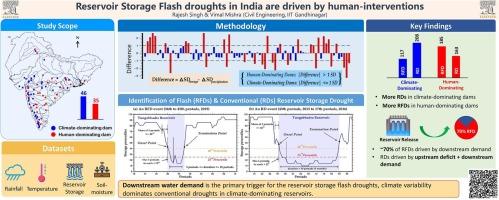印度的水库储水突发性干旱是由人为干预造成的
IF 3.1
Q2 GEOSCIENCES, MULTIDISCIPLINARY
引用次数: 0
摘要
以库容迅速减少为特征的突发性水库干旱(rfd)和常规(长期)库容干旱(RDs)影响着水的可利用性、水力发电和农业活动。然而,印度突发性干旱和常规水库干旱的机制和驱动因素仍未得到探索。通过对水库储水量的日常观测,我们确定了2000-2023年期间印度81个主要水库的rfd和RDs。81个水库中有46个受上游气候影响,因为水库蓄水量趋势受上游降水变化和变率的驱动,其余35个水库被确定为人类主导水库。在以人为主导的水库中,特别是在小型水库中,rfd发生的频率高于以气候为主导的水库。在气候和人为主导的水库中,大约70%的rfd是由于下游地区为满足增加的用水需求而突然释放造成的。上游降水亏缺和下游需水量控制着rfd,下游需水量仅能驱动rfd。与水库蓄水趋势不同,水库蓄水干旱主要与下游用水需求有关。我们强调了气候和人为干预在印度水库蓄水/干旱中的作用。本文章由计算机程序翻译,如有差异,请以英文原文为准。

Reservoir storage flash droughts in India are driven by human interventions
Reservoir storage flash droughts (RFDs), characterized by the rapid decline in reservoir storage, and conventional (long-term) reservoir storage droughts (RDs) impact water availability, hydropower generation, and agricultural activities. However, the mechanism and drivers of flash and conventional reservoir storage droughts in India remain unexplored. Using daily observations of reservoir storage, we identify RFDs and RDs in 81 major reservoirs in India during the 2000–2023 period. 46 out of 81 reservoirs are dominated by upstream climate as reservoir storage trends are driven by changes and variability in upstream precipitation, while the remaining 35 reservoirs are identified as human-dominating reservoirs. RFDs occur more frequently in human-dominating reservoirs than climate-dominating, especially in small reservoirs. About 70 % of RFDs in climate and human-dominating reservoirs are caused by sudden release to meet increased water demands in the downstream regions. Additionally, upstream precipitation deficit and downstream water demand control RDs, while downstream water demands can solely drive RFDs. Unlike reservoir storage trends, reservoir storage droughts are mostly linked with downstream water demands. We highlight the role of climate and human interventions in reservoir storage/droughts in India.
求助全文
通过发布文献求助,成功后即可免费获取论文全文。
去求助
来源期刊

Journal of Hydrology X
Environmental Science-Water Science and Technology
CiteScore
7.00
自引率
2.50%
发文量
20
审稿时长
25 weeks
 求助内容:
求助内容: 应助结果提醒方式:
应助结果提醒方式:


